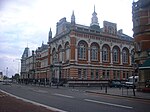Leyton Cricket Ground
Cricket grounds in EssexCricket grounds in LondonDefunct football venues in EnglandEssex County Cricket ClubSport in Leyton ... and 3 more
Sport in the London Borough of Waltham ForestSports venues completed in 1885Use British English from February 2023

Leyton Cricket Ground (formerly known as the County Ground or the Lyttelton Ground) is a cricket ground in Leyton, London. The ground was the headquarters and main home match venue of Essex County Cricket Club from 1886 until 1933, and was also used by the club for matches between 1957 and 1977. It currently hosts club and community cricket matches and has a listed pavilion.
Excerpt from the Wikipedia article Leyton Cricket Ground (License: CC BY-SA 3.0, Authors, Images).Leyton Cricket Ground
High Road Leyton, London Leyton (London Borough of Waltham Forest)
Geographical coordinates (GPS) Address Nearby Places Show on map
Geographical coordinates (GPS)
| Latitude | Longitude |
|---|---|
| N 51.567344444444 ° | E -0.010783333333333 ° |
Address
High Road Leyton
E10 6RT London, Leyton (London Borough of Waltham Forest)
England, United Kingdom
Open on Google Maps







